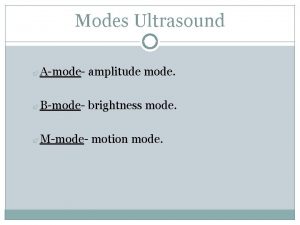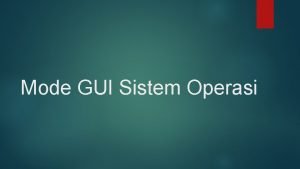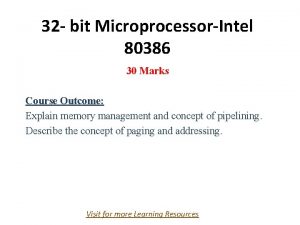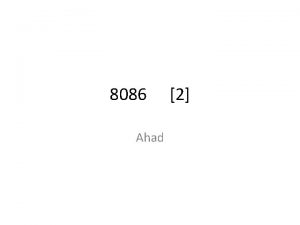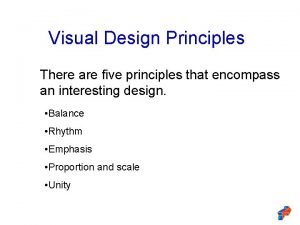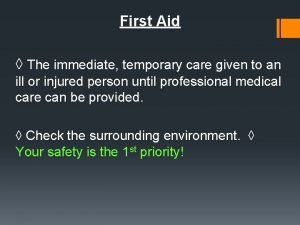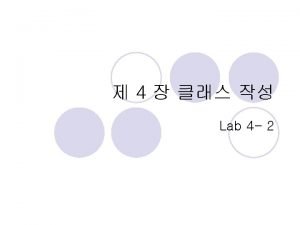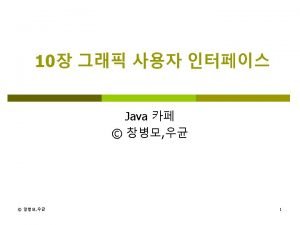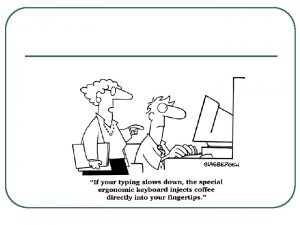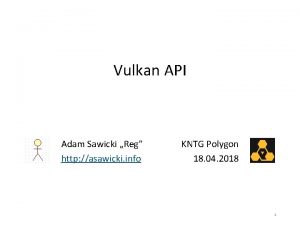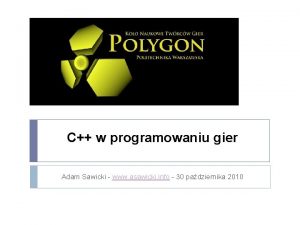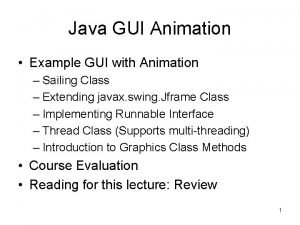Immediate Mode GUI Theory and Example Adam Sawicki





















- Slides: 21

Immediate Mode GUI – Theory and Example Adam Sawicki http: //asawicki. info

What is GUI? Graphical User Interface (GUI) aka Head-Up Display (HUD) • Displays information • Handles interaction • Mouse, touch, keyboard, other controllers… 2

Implementation 1. Default system controls • • (Used in desktop apps) Pure system API: Win. API C++ library: Qt, wx. Widgets, … Another programming language: C#, Java, … 3

Implementation 1. Default system controls 2. Custom rendering • (Used in games, graphics apps) • Library: Scaleform, Dear Im. Gui, … • Your own implementation 4

Architecture Object-oriented – seems to be the most natural architecture for GUI • Class hierarchy for types of controls • Design patterns, e. g. composite • Fields: Position, Size, … • Methods: Show, Hide, Enable, Disable, … 5

Architecture Object-oriented – seems to be the most natural architecture for GUI 6

Example 7

Some thoughts • Actual objects also form a hierarchy • Every control is positioned relative to its parent • Similar to how games represent scene • High-level approach found in game engines – hiearchy of objects 8

Immediate mode GUI – idea • On low level (Direct. X, Open. GL, Vulkan), rendering is stateless – „immediate mode” • Sequence of draw calls repeated every frame • • • Set. Shader Set. Texture Draw. Triangles … • What if… we could render GUI this way? 9

Dear Im. Gui • https: //github. com/ocornut/imgui • C++ library • Bindings to many languages available • License: MIT • Author: Omar Cornut (game developer) • Suited for real-time rendering • Efficient • Graphics API agnostic 10

Example code if(Im. Gui: : Begin("First Window")) { Im. Gui: : Text("Do you like it? "); Im. Gui: : Button("Yes"); Im. Gui: : Button("No"); Im. Gui: : End(); } 11

Q: How are controls positioned? • Automatic – each control in new row • You can change this: • • Push. Item. Width(item_width), Same. Line() Columns: Columns(count) Grouping: Begin. Group(), End. Group() Full control: Get. Cursor. Pos(), Set. Cursor. Pos(local_pos) 12

Q: How do I handle feedback? You receive it the same moment you define a control Im. Gui: : Text("Do you really want to quit? "); if(Im. Gui: : Button("Yes")) Exit. Program(); if(Im. Gui: : Button("No")) Close. This. Window(); 13

Q: Where is value of controls? • In your own variables • You pass pointers to them as you define controls float volume = 0. 7 f; bool mute = true; Im. Gui: : Slider. Float("Volume", &volume, 0. 0 f, 1. 0 f); Im. Gui: : Checkbox("Mute", &mute); 14

Q: How about other state? • There is other state • Window position & size, focus, text selection, … • Kept inside Im. Gui library • So it’s not truly stateless… • Controls are identified by hash from their labels • If not unique, you can use "Label##UNIQUE_ID" • You can also scope your labels: Push. ID(), Pop. ID() 15

Q: How to render? • If your frame has Update() and Render(): • Do all Im. Gui inside Update() • Inside Render() you must render it yourself • For rendering you receive a sequence of: • • Vertex array Index array Texture ID Scissor rectangle • Examples available for: Direct. X 9, 10, 11, Open. GL, Vulkan, Allegro, … 16

Features: Property grid • Suited to provide editing of properties of various types • bool, int, float, string, enum • vec 2, vec 3, vec 4, color 17

Features: Fonts • Supports TTF fonts, loaded into atlas texture • You receive data for this texture, need to upload it to GPU by yourself 18

Live demo 19

Conclusion • Dear Im. Gui is good for: • Internal in-game GUI for debugging purposes • Easy to use • Efficient to render • Dear Im. Gui is not good for: • Fully-featured game editor • Not well suited for complicated GUI, better use system controls • Final game HUD • No possibility of skinning or making it look pretty • You can always make your own implementation • Based on idea of Immediate Mode GUI! 20

Thank you Questions? 21
 Immediate mode gui
Immediate mode gui Lithotripsy
Lithotripsy Ge gi gue gui güe güi
Ge gi gue gui güe güi Creative commons
Creative commons Hlt addressing mode
Hlt addressing mode Immediate addressing mode
Immediate addressing mode Aplikasi desktop linux yang banyak digunakan pada mode gui
Aplikasi desktop linux yang banyak digunakan pada mode gui Focus mode and diffuse mode
Focus mode and diffuse mode Real protected and virtual modes of 80386
Real protected and virtual modes of 80386 8088 data bus
8088 data bus Adam white facebook
Adam white facebook Mode địa chỉ tức thì là mode
Mode địa chỉ tức thì là mode Which mode is defined as 8 bit auto reload mode of timer
Which mode is defined as 8 bit auto reload mode of timer Gartner mode 1 mode 2
Gartner mode 1 mode 2 Perbedaan (planning mode) dan (evolutionary mode)
Perbedaan (planning mode) dan (evolutionary mode) Adam hayes and hopson
Adam hayes and hopson Gui toolkit is an example of low-level api for native apps.
Gui toolkit is an example of low-level api for native apps. Adam smith's invisible hand theory
Adam smith's invisible hand theory Every individual is continually exerting himself
Every individual is continually exerting himself Benefits of protectionism economics
Benefits of protectionism economics Five principles of design
Five principles of design Temporary care given to a person
Temporary care given to a person

